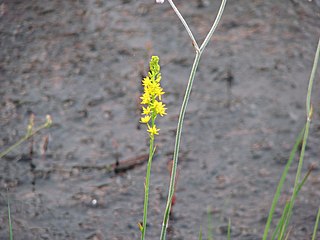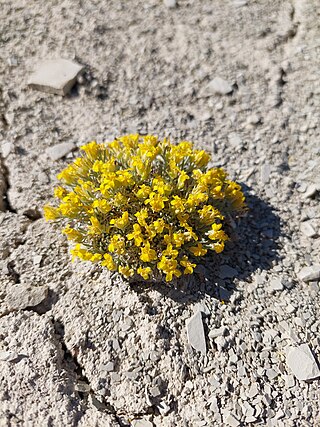
Spiranthes is a genus of orchids in the subfamily Orchidoideae. They are known commonly as ladies tresses, ladies'-tresses, or lady's tresses. The genus is distributed in the Americas, Eurasia, and Australia. The genus name Spiranthes is derived from the Greek speira ("coil") and anthos ("flower"), and was inspired by the spirally arranged inflorescence.

Narthecium americanum is a species of flowering plant in the Nartheciaceae known by the common names yellow asphodel and bog asphodel. It is native to New Jersey in the United States. It is now apparently limited to that state, having likely been extirpated from Delaware, North Carolina, and South Carolina.

Spiranthes spiralis, commonly known as autumn lady's-tresses, is an orchid that grows in Europe and adjacent North Africa and Asia. It is a small grey-green plant. It forms a rosette of four to five pointed, sessile, ovate leaves about 3 cm (1.2 in) in length. In late summer an unbranched stem of about 10–15 cm (3.9–5.9 in) tall is produced with approximately four sheath-shaped leaves. The white flowers are about 5 mm (0.20 in) long and have a green spot on the lower lip. They are arranged in a helix around the upper half of the stalk. The species is listed in Appendix II of CITES as a species that is not currently threatened with extinction but that may become so. Autumn lady's-tresses are legally protected in Belgium, UK and the Netherlands, and in some regions of France.

The Canelo Hills Cienega Reserve, is a nature preserve southeast of Sonoita, Arizona on the east side of the Canelo Hills. The area's 260 acres (110 ha) are a mix of rare cienega wetland and black oak and Arizona fescue fields. The preserve is notable for the extremely rare Canelo ladies tresses orchid and the Gila chub and Gila sucker that grow along its alkaline banks. The ranch was purchased by the Nature Conservancy in 1969 from the Knipes family. It was designated a National Natural Landmark in December 1974.

Spiranthes porrifolia is a species of orchid known by the common names creamy lady's tresses and western ladies' tresses. It is native to the western United States from Washington and Idaho to southern California. It can be found in moist habitats, such as mountain meadows, swamps, fens, and riverbanks. It is a perennial herb growing from a tuberous root system, reaching a maximum height around 60 cm (24 in). The leaves are mainly located around the base of the erect stem. They are linear or lance-shaped, or sometimes nearly oval. The top of the stem is occupied by the inflorescence, a dense spiral of many flowers. Each flower is somewhat tubular, with an upper and lower lip, and cream to yellowish in color.

Amsonia kearneyana is a rare species of flowering plant in the dogbane family known by the common name Kearney's bluestar. It is native to Arizona, where there is only one native population in the Baboquivari Mountains of Pima County. There may also be a population just south of the border in Sonora, Mexico. The plant was federally listed as an endangered species in 1989. At that time the global population of the plant was made up of eight individuals in a riparian canyon. Since that time the plant has been manually propagated in an attempt to increase its numbers. Threats to the tiny native population include habitat destruction from livestock activity and flash floods in the river canyon. Many of the plants cannot reproduce because their seeds are sterile and nonviable, but this is probably due to insect predation on the seeds as they develop.

Chrysopsis floridana is a rare species of flowering plant in the family Asteraceae, known by its common name, Florida golden aster. It is endemic to Florida in the United States, where it is known from Hillsborough, Hardee, Manatee, and Pinellas Counties. It is considered an endemic of the west-central coast of the state in the general vicinity of Tampa Bay. There are 17 to 20 occurrences, many of which have few individuals, but one of which has over one million plants. In 1986 the plant was added to the US endangered species list because it was becoming increasingly rare, it was growing only on private property, and its habitat was unprotected and being destroyed and degraded by a number of forces. It is found at Bell Creek Nature Preserve in Riverview, Florida.

Lysimachia asperulifolia is a rare species of flowering plant in the Primulaceae known by the common name rough-leaved loosestrife and roughleaf yellow loosestrife. It is endemic to the Atlantic coastal plain in North Carolina and northern South Carolina in the United States, where there are 64 known populations. It is a federally listed endangered species of the United States.

Physaria filiformis is a rare species of flowering plant in the family Brassicaceae known by the common names Missouri bladderpod and limestone glade bladderpod. It is native to Missouri and Arkansas in the United States. It was federally listed as an endangered species in 1987 and it was downlisted to threatened status in 2003. P. filiformis remains listed as an endangered species at the state level in Missouri.

Spiranthes diluvialis is a rare species of orchid known as Ute lady's tresses. The species name diluvialis means "of the flood". It is native to the western United States, where there are scattered, mostly small occurrences in the states of Colorado, Idaho, Montana, Nebraska, Nevada, Utah, Washington, and Wyoming. Two occurrences were discovered in southern British Columbia in 2006. The plant faces a number of threats to its existence. It is a federally listed threatened species of the United States.

Xyris tennesseensis is a rare species of flowering plant in the family Xyridaceae known by the common name Tennessee yellow-eyed grass. It is native to a small section of the Southeastern United States, including parts of the states of Alabama, Georgia, and Tennessee. A federally listed endangered species, it is threatened by the loss and degradation of its habitat.

Panicum hemitomon is a species of grass known by the common name maidencane. It is native to North America, where it occurs along the southeastern coastline from New Jersey to Texas. It is also present in South America.
Eriogonum visheri is a species of wild buckwheat known by the common names Dakota wild buckwheat and Visher's buckwheat. It is native to the Great Plains in the United States, where it is known from North Dakota, South Dakota, and Montana.

Poa paludigena is a species of grass known by the common names bog bluegrass, marsh bluegrass, slender marsh bluegrass, and Patterson's bluegrass. It is native to the northeastern United States.
Rumex orthoneurus is a species of flowering plant in the knotweed family known by the common names Chiricahua Mountain dock and Blumer's dock. It is native to western North America, where it can be found in Arizona, New Mexico, and Sonora.

Physaria tumulosa, known by the common name Kodachrome bladderpod, is a rare species of flowering plant in the family Brassicaceae. It is endemic to Utah in the United States, where it is known only from Kane County. There is only one known population of this plant, made up of scattered occurrences totaling about 20,000 individuals, all within the Kodachrome Basin. The plant is threatened by the loss and degradation of its habitat. It is federally listed as an endangered species. It was previously treated as a subspecies of Physaria hitchcockii.

Spiranthes tuberosa, commonly called little lady's tresses, little pearl-twist and slender ladies'-tresses is an orchid species. It is a perennial plant native to North America.
Spiranthes graminea or the Canelo lady's tresses is a species of orchid found in Mexico and Central America.
Schiedeella arizonica is a species of Orchid native to the southwestern United States. It was first described by Paul Martin Brown in 2000. This species additionally goes by several common names including fallen ladies tresses, parasitic lady's tresses, and Indian-braids.
















